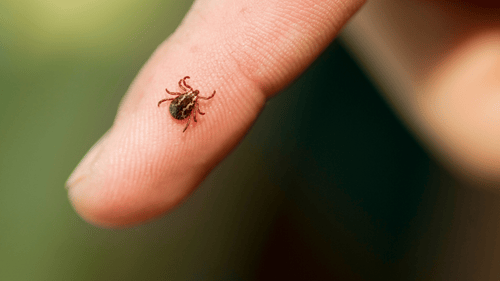Recognising Tick Bites and Early Symptoms of Lyme Disease
Published: 05/06/25
Our colleagues at LDUK have put together the following information to help raise awareness of Lyme Disease amongst community pharmacy health professionals.
If you do have any questions please contact LDUK at: awareness@lymediseaseuk.com
As we move into Summer, pharmacy teams may start to see people presenting with tick bites and potentially symptoms of Lyme disease.
While tick bites/Lyme disease are not treatable under the NHS Pharmacy First Scotland clinical pathway for infected insect bites, patients may present after a tick bite with an erythema migrans (EM) rash – also known as a bullseye rash, and need to be referred on to their GP. Understanding more about the signs and symptoms should help pharmacy teams recognise the symptoms and allow them to signpost patients as appropriate.
Pharmacists can play an essential part in the early recognition of symptoms of Lyme disease by promptly signposting people on to their GP.
About Lyme disease
Lyme disease is a bacterial infection caused by the spirochete Borrelia Burgdorferi. The infection is spread by ticks infected with the bacteria. Ticks are mainly found in grassy areas and woodlands but have also been found in urban parks and gardens. It is estimated that only about 5-10% of ticks carry the bacteria that causes Lyme disease which can be reassuring when a person seeks advice after a tick bite.
How to remove a tick
If a person presents with an embedded tick, it must be removed correctly and not with anything not designed for the job. Never stress the tick by covering it by anything to make it fall off (i.e. Vaseline). A stressed tick can respond by regurgitating the contacts of its stomach into the host’s bloodstream. A tick should be removed with a tick tool or a pair of fine tipped tweezers. If a tick tool is available, slide the fork-like part of the tool underneath the tick, twist the tool which will loosen the grip of the tick and pull upwards (See instructions for the tool that you use). If using fine tipped tweezers, grasp the tick as close to the skin as possible and pull straight upwards. Clean the area with an antiseptic wipe and give advice about type of symptoms to observe for over the next few weeks. If the tick is not removed cleanly and the mouthparts remain embedded, the body will dispel them like any other foreign body, but the person should be advised to observe for any signs of localised infection that might need treatment. Retained mouthparts do not increase the risk of contracting Lyme disease.
* Prophylactic treatment after a tick bite is not usually recommended by the NHS but the Royal College of GP Lyme disease toolkit does suggest that it can sometimes be considered for certain high-risk cases.
Early symptoms
The most obvious sign of Lyme disease is an erythema migrans rash, sometimes referred to as a bullseye rash. However, it is estimated that about 30% of people infected with Lyme disease do not develop a rash. As well as the typical bullseye presentation, the rash can have a solid or bruise like appearance. It can appear very differently on darker skins and be harder to spot. The behaviour of the rash is very important when considering diagnosis.
It is always delayed in appearance (from 3 days after a bite, up to 3 months)
generally not itchy or painful
slowly spreads outwards as its name indicates
The spreading is the tell-tale sign of an erythema migrans rash. In some cases, erythema migrans rashes can become huge. Any redness, itchiness or swelling immediately after a bite is likely to be a histamine reaction.
Other symptoms to look out for are:
flu-like symptoms
headache
neck ache
sore muscles and joint pain
fatigue
feeling generally very unwell
It can often be misdiagnosed as an insect bite, cellulitis, ringworm or an allergic reaction. Good history taking is essential. If an erythema migrans rash is diagnosed treatment with antibiotics should begin straight away with no need for a blood test as an erythema migrans rash is diagnostic for Lyme disease. If Lyme disease is suspected but there is no erythema migrans rash present, serology testing should be carried out.
Late diagnosis or misdiagnosis can lead to long term debilitating symptoms that can be difficult to treat, and it is very important that pharmacists who are presented with a tick bite, erythema migrans rash or other early symptoms of Lyme disease are aware of the importance of early signposting to the GP.
Visit Lyme Disease UK’s dedicated webpage for pharmacy teams for further resources including: how to recognise the erythema migrans (Lyme ) rash, details of how to order tick removal tools and tick awareness leaflets for your pharmacy and to download the ‘Be Tick Aware’ animation for pharmacy screens.
RESOURCES









A community pharmacy consultation has played a vital role in the early detection and treatment of a suspected case of Lyme disease, thanks to the vigilance of an Independent Prescribing (IP) Pharmacist and the power of public health awareness.